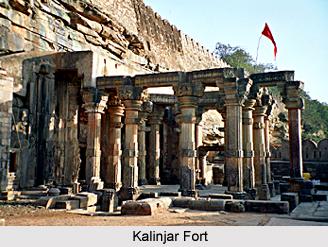 Kalinjar is one of the most ancient sites in Bundelkhand, and is a highly sanctified place and is fortified by both nature and man. It is a classic example of a venerated hill shrine converted into a hill fortress and occupied by successive generations of invaders. It boasts of one of the oldest forts in India, referred as Kanagora. The fort of Kalinjar is a trove of temples and sculptures. It depicts the artistic expertise of the Chandela dynasty.
Kalinjar is one of the most ancient sites in Bundelkhand, and is a highly sanctified place and is fortified by both nature and man. It is a classic example of a venerated hill shrine converted into a hill fortress and occupied by successive generations of invaders. It boasts of one of the oldest forts in India, referred as Kanagora. The fort of Kalinjar is a trove of temples and sculptures. It depicts the artistic expertise of the Chandela dynasty.
Modern historians refer that the fort of Kalinjar was built by the Chandela king Kedar Burman in the seventh century AD. The fort stands on a height of 1000 feet above a hill. The fort is so grand in its architectural style that there is almost no parallel to this magnificent piece of architecture.
In the early times the fort was ruled by Hindu kings but later on it came under the reign of Muslim rulers. But it can be said that other than the Chandela rulers who were known as the originator of the fort none other could hold the fort in a proper manner for long. Finally the fort came under the control of the British government.
An old legend is associated with the fort. It is said that Lord Shiva had slain the god of time on the hill on which the Kalinjar Fort stands. From then on the hill is considered holy and the fort is named as Kalinjar Fort because the word "kal" means time and "jar" means destruction.
The Kalinjar Fort can be reached by ascending the steps cut on the hill sides. The fort can be entered through the seven gates. Seven gates of the fort are namely the Alamgir Darwaza, Ganesh Dwar, Chauburji Darwaza, Buddha Bhadra Darwaza, Hanuman Dwar, Lal Darwaza and Bara Darwaza.
The Alamgir Darwaza is named after Alamgir or Aurangzeb, to whom there is a Persian inscription. The rough path to the Ganesh Dwar is called Kafir Ghat. The third gate, Chauburji Darwaza, is a double one. A stone to the right carries a Sanskrit inscription. The fourth, Buddha Bhadra Darwaza, is approached by a flight of steps. A break in the wall beyond permits an ascent to the Bhairan Kund, a large tank hewn from solid rock, above which is a gigantic carved figure of Bhairan. Below is a water-filled cave, used as a hot-weather retreat, in which inscriptions dating from the Chandel-Chauhan wars of 1193 can be found.
The fifth gate, the Hanuman gate, lies surrounded by numerous sculptures and inscriptions. The sixth gate is called Lal Darwaza and the seventh, the Bara Darwaza, or main gate, is flanked by two iron cannon on stone barbettes.
Beyond the gate is a drop of about 12 ft which leads to Sita Sej, a stone couch in a chamber hewn from the rock. The inscription over the door is 4th century. Beyond is a passage to Patal-ganga, a cave receding about 40 ft into the hillside. To the north-east is the Pandu Kund. Fragments of architectural ornament can be seen in the shattered walls. Next is a large tank called the Budha Badra. Continuing the circuit of the fort the Panna Gate is reached on the angle of the hill. To the east lies the Mrigdhara, so called for the seven deer cut into the rock. The two chambers are crowned by a domed and a pyramidal roof respectively, and within one there is a cistern of clear water.
At the centre of the fort, is a large tank known by the name Kot Tirth, 91 m long, once surrounded by sculptures and the linga and yoni forms of Shiva and Parvati are also found there.
As the Chandelas were great devotees of Lord Shiva several temples within the fort have been dedicated to the lord in different forms.
The Neelkanth Mahadev Temple located on the western side of the fort is a splendid piece of architecture within the fort. The temple has a cave like opening and within the temple is a Shivalingam of height 4.6 feet. Just near the Shivalinga is the idol of Bhairvai and his consort goddess Parvati. Along with the idols of Bhairav and Parvati there are other decorated and ornated images and pillars all over the temple.
The palace of Aman Singh, a Chandela King has several beautiful sculptures made of sandstone and granite. Most of the sculptures in the palace depict various gods and goddesses. In the fort there are several images of Trimurti representing the three Hindu gods Lord Brahma, Lord Vishnu and Maheshwar. The image of Lord Mahavir and Kamdev also suggest the influence of various cultures.
The Venkat Bihari Temple also represents a majestic look from outside. The temple represents a traditional Hindu style of architecture. The various kunds which are found within the temple area speaks about the architectural skill of the Chandelas.
Throughout the fort are many Muslim tombs, as well as relics of the Bundelas and Chaubas. The British had also left their mark by building a fine monument to Andrew at the highest point of the fort.
Thus, the fort of Kalinjar not only served as a military architecture but is an important piece of architecture which attracts large number of tourists. The Fort of Kalinjar also shows the blending of different architectural style namely the Hindus, the Islam and also the British. Hence Kalinjar Fort is a treat for the eyes.



















